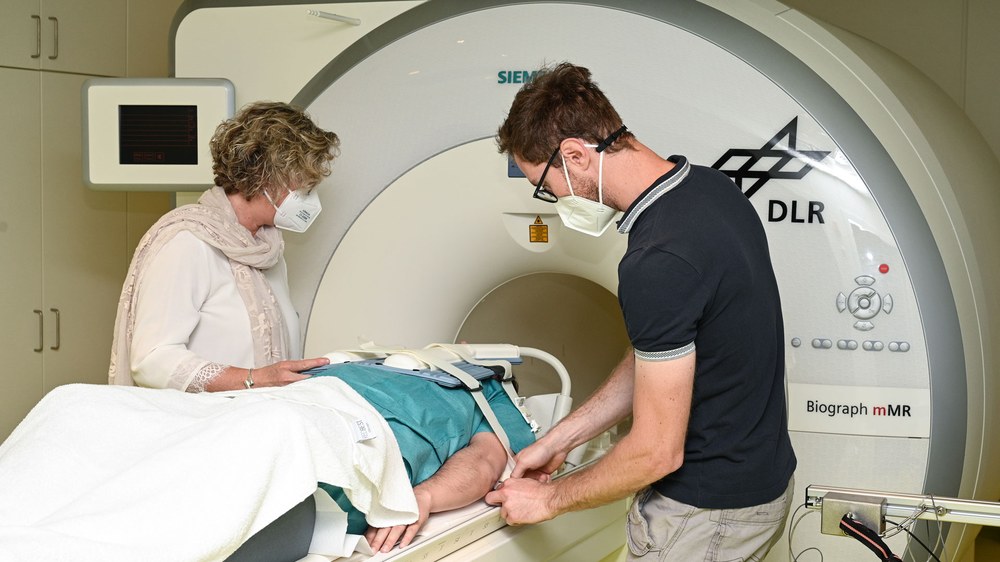Findings of study open up new possibilities for people with single-ventricle hearts



- Joint study by Bonn University Hospital, DLR and other participants investigates the effects of flying and high-altitude conditions on patients with Fontan circulation.
- Conditions similar to those at an altitude of 2500 metres or in a commercial aircraft were simulated for 18 test subjects at the :envihab facility.
- With this study, the research team was able to close a knowledge gap.
- Focus: Aeronautics, medicine, health
Taking a long flight or spending a night in the mountains: for many patients with a Fontan circulation (single-chamber heart), this was previously unimaginable because the effects on their cardiovascular system had not been sufficiently examined. A study conducted by the University Hospital Bonn (UKB) together with the German Aerospace Center (Deutsches Zentrum für Luft- und Raumfahrt; DLR) and the German Sport University Cologne has now shown that it is possible for people with a Fontan circulation to remain at altitude for 24 to 30 hours, including an overnight stay. In consultation with their physicians, the study results enable Fontan-patients to participate in more activities. During the tests, conditions at the DLR medical research centre :envihab were similar to those encountered at an altitude of 2500 metres above sea level – or in a passenger aircraft.
Eighteen test participants spent four days and three nights at DLR. During this time, the researchers investigated the influence of hypoxia (oxygen deficiency) at the simulated altitude on various cardiological and metabolic parameters. Among other things, they measured the intracardiac pressure and analysed the blood flow in the lungs using real-time magnetic resonance imaging. The results showed that neither the blood pressure nor the blood flow in the lungs changed significantly. According to the research team, the findings indicate that clinically stable patients with a single-chamber heart "can endure being at an altitude of 2500 metres for 24 to 30 hours."
Patient-orientated research under controlled conditions
":envihab offers unique opportunities for patient-orientated research. The examinations cannot be carried out at altitude under actual conditions. However, at :envihab we were able to examine Fontan patients over several days and nights under very comfortable conditions and safely expose them to an oxygen-reduced atmosphere. We very much hope to be able to conduct further studies together in the future," says Jens Tank from the DLR Institute of Aerospace Medicine in Cologne.
Fontan patients have a complex congenital heart defect with only one functioning ventricle that pumps blood into the circulatory system. The heart and blood vessels are operated on in several interventions, which are carried out in infancy and childhood, so that the oxygen-poor blood flows directly into the lungs. As a result, the heart and lungs can only supply the body with oxygen to a limited extent during exertion. In Germany, approximately 200 people are born with this complex heart defect every year. The first life-saving operation was named after the surgeon Francis Fontan.
Eighteen patients aged between 16 and 40 took part in the HypoFon study (a combination of 'hypoxia' and 'Fontan'). Whilst under the care provided by :envihab, they were able to push themselves to their physical limits under controlled conditions. For example, the participants cycled on an ergometer or completed jumping and standing tests. After a familiarisation phase, the oxygen content in the laboratory was lowered from 21 to 15.2 percent oxygen. This value is comparable to the mountain air at 2500 metres above sea level or a passenger plane at cruising altitude.
During the cardiovascular examinations with magnetic resonance imaging, the participants wore a breathing mask to ensure that the breathing air conditions remained constant. The entire research team with a variety of medical specialisations worked closely together during the study. The test participants also had the opportunity to share their experiences in everyday life.
Altered breathing during sleep
The researchers also analysed the oxygen saturation of the blood during sleep - an important topic for those affected: "The breathing pattern is fundamentally different when sleeping at high altitudes. Even in healthy people, breathing is altered with short pauses. Fortunately, the evaluations showed that oxygen saturation is also high enough during sleep and that the change is even comparable to that of healthy people," explains Nicole Müller from the Department of Paediatric Cardiology at the UKB. "Previously, we only had study data on the effects of short-term hypoxia on their cardiovascular system. Data on prolonged hypoxia, including overnight stays, has been lacking. Many of those affected have never dared to spend a longer period at altitude in their lives, such as a flight to Australia or an overnight stay in the mountains. Our study now shows that, under certain conditions, this poses no health risk."
"This is a great medical development and contributes to improving the lives of all patients with congenital heart defects," adds Sylvia Paul, Chair of the Children's Heart Foundation, which supported the study. The results of the study have now been published in the scientific journal Circulation.
